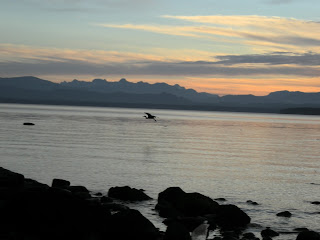First of all, mealtimes are different here. Breakfast is early, but lunch is anywhere between 1:30 and 4:00; this is the main meal of the day... after that there are always tapas.
At lunchtime there's often a Menu del dia, or menu of the day, or special. This includes an appetizer, entree, and dessert. Our favourite was in Granada, where for the appetizer Brad had paella and I had salad, and for the entree we both had tuna, which turned out to be enormous tuna steaks, and for dessert there was flan.
Also in Granada was a rather surprising meal: Brad had seafood soup, which included everything in its shell: clams and prawns; I ordered sole, and was surprised to have a plate put in front of me with two fish, bones included!
As soon as you order a drink, a small tapa usually follows: often olives, or a small vegetable dish. Also served is bread and breadsticks; there's always olive oil and vinegar on the table: for your salad, and also you put olive oil on your bread.
The draft beer is like light beer at home, and here in Southern Spain (not the case in the north we hear), you can order a small beer, called a cana. The red wine is very good, as is the sangria.
We've had some delicious tapas: deep fried eggplant with honey, mushrooms with garlic, artichokes with onions, prawns and potato...
Of course dessert is another whole category. The hot chocolate and churros in Madrid were delicious.
The confiterias (pastry shops) are outrageous with their extensive selection, and have to be tried.
There are small fruit stands and shops everywhere you go, and some have signs that say "don't touch the fruit!" You just say what it is you want, and the shopkeeper selects it for you.
 |
| Hot chocolate and churro, by Moyan Brenn CC |


















































